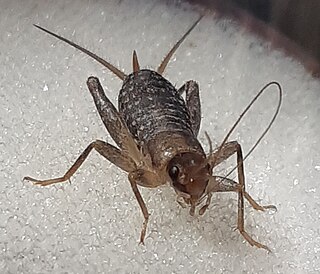
The orthopteran family Rhaphidophoridae of the suborder Ensifera has a worldwide distribution. Common names for these insects include cave crickets, camel crickets, Hogan bugs, spider crickets, land shrimp, and sand treaders. Those occurring in New Zealand are typically referred to as jumping or cave wētā. Most are found in forest environments or within caves, animal burrows, cellars, under stones, or in wood or similar environments. All species are flightless and nocturnal, usually with long antennae and legs. More than 500 species of Rhaphidophoridae are described.

The family Gryllidae contains the subfamilies and genera which entomologists now term true crickets. Having long, whip-like antennae, they belong to the Orthopteran suborder Ensifera, which has been greatly reduced in the last 100 years : taxa such as the spider-crickets and allies, sword-tail crickets, wood or ground crickets and scaly crickets have been elevated to family level. The type genus is Gryllus and the first use of the family name "Gryllidae" was by Francis Walker.

Gryllinae, or field crickets, are a subfamily of insects in the order Orthoptera and the family Gryllidae.

Ensifera is a suborder of insects that includes the various types of crickets and their allies including: true crickets, camel crickets, bush crickets or katydids, grigs, weta and Cooloola monsters. This and the suborder Caelifera make up the order Orthoptera. Ensifera is believed to be a more ancient group than Caelifera, with its origins in the Carboniferous period, the split having occurred at the end of the Permian period. Unlike the Caelifera, the Ensifera contain numerous members that are partially carnivorous, feeding on other insects, as well as plants.

Tree crickets are insects of the order Orthoptera. These crickets are in the subfamily Oecanthinae of the family Gryllidae.

Phalangopsinae, occasionally known as spider crickets, are a subfamily of crickets in the family Phalangopsidae. Members of Phalangopsinae are found worldwide in tropical and subtropical regions. Most species in the subfamily are nocturnal and can be found in rocky areas, near fallen wood, and the understory of forests. Some species are gregarious, gathering in large numbers.

Tylopsis lilifolia, the lily bush-cricket, is a species of Orthopterans in the subfamily Phaneropterinae. It is found in Europe and Asia.

Yersinella raymondii, common name Raymond's bush-cricket, is a species of "katydids crickets" belonging to the family Tettigoniidae subfamily Tettigoniinae. The scientific name Yersinella comes from the name of the entomologist who has described the species in 1860.

The Tridactylidae are a family in the insect order Orthoptera. They are small, mole-cricket-like insects, almost always less than 20 mm (0.79 in) long when mature. Generally they are shiny, dark or black, sometimes variegated or sandy-coloured. They commonly live in short tunnels and are commonly known as pygmy mole crickets, though they are not closely related to the true "mole crickets" (Ensifera), as they are included in the Caelifera suborder.

Gryllomorpha is a genus of cricket belonging to the family Gryllidae subfamily Gryllomorphinae. The species of this genus are present in Europe, in North Africa and in Central Asia.

Grylloidea is the superfamily of insects, in the order Orthoptera, known as crickets. It includes the "true crickets", scaly crickets, wood crickets and other families, some only known from fossils.

Sepiana sepium, common name sepia bush-cricket, is a species of bush crickets belonging to the tribe Platycleidini and genus group Platycleis. It is the only species within the monotypic genus Sepiana.

Pseudomogoplistes squamiger, the scaly cricket, is a species of apterous cricket in the family Mogoplistidae. Long known in the genus Mogoplistes it was placed this genus, for which it became the type species, by AV Gorochov in 1984.
The Sclerogryllinae are a subfamily of crickets, in the family Gryllidae, based on the type genus Sclerogryllus. They may be known as "stiff-winged crickets" are terrestrial insects, distributed in: tropical Asia, Korea, Japan and West Africa.

Lepidogryllus is a genus of crickets, sometimes known as mottled field crickets, in the family Gryllidae and tribe Modicogryllini. Species have been found in Australia, New Caledonia and Vietnam.
Hemitrullus is a genus of crickets in the family Gryllidae and tribe Gryllini. Species can be found in Indo-China.

Natula averni is one of the smallest and most elusive species of cricket living in the Mediterranean Basin.

Oecanthus dulcisonans is a species of cricket sparsely but widely distributed in the Mediterranean Basin and in the Middle East.

The Gryllomorphinae are a subfamily of crickets based on the type genus Gryllomorpha. Species have been recorded from: North Africa and the western Palaearctic (mainland).
Ovaliptila is a genus of European crickets in the subfamily Gryllomorphinae and the tribe Petaloptilini, erected by A.V. Gorochov in 2006. The known distribution – possibly incomplete – of species includes: the Balkans, Greece, Turkey and the Crimean peninsula.


















